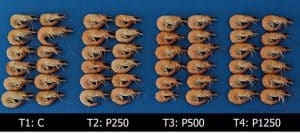The aquafeed industry begs for new ingredients to sustain the growing demand. Insect new born sector is willing to be a new candidate. Initially, these start-up companies were targeting the food market, presenting insects as “the food of the future” (Van Huis et al., 2013- FAO), which could ensure the world food security. Few years later, economics and customer’s reluctance had reasons to this promising market and push most companies to look for alternatives. But aquafeed ingredient candidates should fulfill 4 main requirements the insects may not fully reached for the moment:
Nutritional qualities: Aquafeeds require high protein levels with a well-balanced amino-acid profile. Results depend on the insect species used and the level of processing (chitin extraction). But insect products are characterized for the 2 major ones (yellow mealworm Tenebrio molitor and the black soldier fly, Hermetia illucens), by a high protein content (from 42% to 52% crude protein, source: Feedipedia), a good essential amino acid profile, and fair high lipid content (from 8% to 35%, depending on the lipid extraction process). The second major challenge on the nutritional qualities is related to the digestibility and antinutritional factors. Several works have pointed out some weaknesses of most available insect meals on fish species, especially related to the chitin content which may impair Apparent Digestibility Coefficients.
Supply in sufficient quantity: Aquafeed plants require large quantities and stable supply all year round to validate the use of new ingredients. As silos and bins are always scarce and not sufficient in most plants, insect products will have to be produced in sufficient quantities to justify their choice.
Pricing: the current price of insect meal is still not competitive with other protein sources. In a study conducted by Arru (2019), the economics of Insect meal (Tenebrio molitor) were assessed in the case of a seabass farm, confirming in all situations the insect meal price should be lower than 2.5 €/kg to be at least included. The high energy requirements along the production cycle and the use of high value by-products for feeding significantly impact the production costs. Will the up-scale reduce significantly the final price?
Sustainability: The insect industry has promoted the concept of a circular economy and zero waste by mass rearing on byproducts. Reality is rather different as the actual regulation bans the use of some by-products for safety reasons. Furthermore, plants need to feed the insects with stable and high quality ingredients, all of them already used by the feed industry! The potential waste user became a commodity competitor! Recent studies have also pointed out the poor Life Cycle Assessment of the process. Even though it is quite too soon to confirm these conclusions in large scale production units, Thevenot (2017) has approached the LCA of one kg of protein of mealworm larvae meal, soybean meal, and fish meal delivered in France as described in table 1.
Mealworm larvae meal (this study) | Soybean meal (Brazil) | Fish meal (Peru) | |
CED (MJ) | 217.37 | 31.17 | 25.62 |
CC (kg CO2 eq) | 5.77 | 4.09 | 1.69 |
AP (g SO2 eq) | 39.38 | 17.61 | 6.59 |
EP (g PO4 eq) | 23.03 | 16.45 | 2.63 |
LU (m2a) | 6.35 | 4.34 | 0.01 |
Table 1: Comparison of life cycle impact assessment of one kg of protein of mealworm larvae meal, soybean meal, and fish meal delivered in France. Inventories of soybean meal and fish meal are extracted from ECOALIM database (Wilfart et al., 2016). CED = cumulative energy demand, CC = climate change, AP = acidification, EP = eutrophication, LU = land use. Source: Thevenot et al.,2017.
Conclusion: The requirements from the aquafeed industry are well known and clearly defined. Marketing claims promoting fish fed with insects might open a niche market but should not hide the clear weaknesses of these products at a large-scale use. In our opinion, new ingredients from vegetable protein concentrates, single cell proteins or micro-algae might represent more robust candidates for the coming years. For the insect industry, larger quantities are announced in the coming 2 years and will definitively allow to get a better opinion of the future potential.
References:
Arru, B., Furesi, R., Gasco, L., Madau, F. A., & Pulina, P. (2019). The introduction of insect meal into fish diet: The first economic analysis on European sea bass farming. Sustainability, 11(6), 1697.
Feedipedia.org – Animal feed resources information system
Thevenot A, Rivera JL, Wilfart Auré, Maillard Fréé, Hassouna M, Senga- Kiesse T, Le Féon S, Aubin Joë, Mealworm meal for animal feed: Environmental assessment and sensitivity analysis to guide future prospects, Journal of Cleaner Production (2017).
Van Huis, A. ; Van Itterbeeck, J. ; Klunder, H. ; Mertens, E. ; Halloran, A. ; Muir, G. ; Vantomme, P., 2013. Edible insects – Future prospects for food and feed security. FAO Forestry Paper 171.



